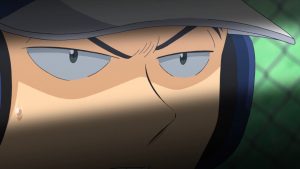 It’s sequences like this, I suppose, that separate the wheat from the chaff as far as sports anime are concerned. If the Hippocratic Oath for comedies is “first, be funny”, then for sports series it’s surely “get the damn games right”. The key to great sports anime is no different than any other genre in the larger sense – strong characters, good pacing, interesting premise et al. But a thorough understanding of the sport in question and the ability to communicate it in entertaining fashion is the foundation on which all that must rest.
It’s sequences like this, I suppose, that separate the wheat from the chaff as far as sports anime are concerned. If the Hippocratic Oath for comedies is “first, be funny”, then for sports series it’s surely “get the damn games right”. The key to great sports anime is no different than any other genre in the larger sense – strong characters, good pacing, interesting premise et al. But a thorough understanding of the sport in question and the ability to communicate it in entertaining fashion is the foundation on which all that must rest.
 Fortunately with Major, that could hardly be less of a concern. Mitsuda-sensei is God-tier in this respect and Watanabe Ayumu is directing. But here Major is moving into hard-core baseball geek territory – this is about as “inside baseball” as the series has ever gotten. And that’s fitting for a game in which Komori is one of the managers – he’s a grinder and tactician of the highest order. All of the mains in this series are the progeny of Goro in some sense, not just Daigo – it was his passion for baseball and his infectious genius for it that set the likes of Satou Toshiya and Komori Daisuke down this path in the first place.
Fortunately with Major, that could hardly be less of a concern. Mitsuda-sensei is God-tier in this respect and Watanabe Ayumu is directing. But here Major is moving into hard-core baseball geek territory – this is about as “inside baseball” as the series has ever gotten. And that’s fitting for a game in which Komori is one of the managers – he’s a grinder and tactician of the highest order. All of the mains in this series are the progeny of Goro in some sense, not just Daigo – it was his passion for baseball and his infectious genius for it that set the likes of Satou Toshiya and Komori Daisuke down this path in the first place.
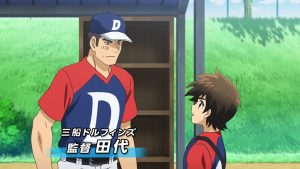 As expected, there’s more to Komori’s kyoujin of a pitcher than just the eephus pitch, and more to his strategy. His fielders employ a shift (an increasing component of professional baseball, to the tune of some controversy) on every eephus pitch, which robs Daigo of a hit in the first inning despite his squaring up the eephus beautifully. A dropped third strike on Urabe leads to the disclosure of their pitcher’s other weapon – as I suspected, he has a good fastball too. He employs a “snap” pitch, effectively throwing the ball like an infielder – and because he’s so big and strong, even giving up the velocity he’d have with a normal delivery it’s still plenty fast. Especially as a contrast to the moonballs he normally throws.
As expected, there’s more to Komori’s kyoujin of a pitcher than just the eephus pitch, and more to his strategy. His fielders employ a shift (an increasing component of professional baseball, to the tune of some controversy) on every eephus pitch, which robs Daigo of a hit in the first inning despite his squaring up the eephus beautifully. A dropped third strike on Urabe leads to the disclosure of their pitcher’s other weapon – as I suspected, he has a good fastball too. He employs a “snap” pitch, effectively throwing the ball like an infielder – and because he’s so big and strong, even giving up the velocity he’d have with a normal delivery it’s still plenty fast. Especially as a contrast to the moonballs he normally throws.
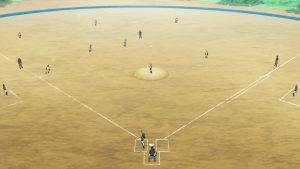 That snap throw is the key to getting Urabe thrown out trying to steal, but it’s also the clue Daigo needs to figure out the key to Komori and the Beetles’ defensive puzzle (with an adorable blush when Tashiro praises him for it). The infielders tense up and drop into a classic poised position when they know a fastball is coming; when it’s an eephus, they’re getting ready to shift. These are kids, after all – but that’s a two-edged sword. Even if the Dolphins know what pitch is coming thanks to Daigo’s keen observation, they still have to deal with it – and that’s extremely difficult for 12 year-olds. That sort of variation in velocity is a bear, and it’s only Hikaru (so baseball-dense he doesn’t even realize he gets to hit first the next inning after Urabe is thrown out stealing during his at-bat) who manages to make solid contact (though to no avail).
That snap throw is the key to getting Urabe thrown out trying to steal, but it’s also the clue Daigo needs to figure out the key to Komori and the Beetles’ defensive puzzle (with an adorable blush when Tashiro praises him for it). The infielders tense up and drop into a classic poised position when they know a fastball is coming; when it’s an eephus, they’re getting ready to shift. These are kids, after all – but that’s a two-edged sword. Even if the Dolphins know what pitch is coming thanks to Daigo’s keen observation, they still have to deal with it – and that’s extremely difficult for 12 year-olds. That sort of variation in velocity is a bear, and it’s only Hikaru (so baseball-dense he doesn’t even realize he gets to hit first the next inning after Urabe is thrown out stealing during his at-bat) who manages to make solid contact (though to no avail).
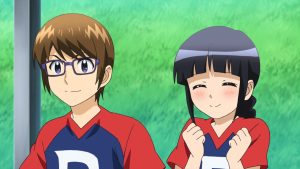 While Urabe and Daigo manage to stop the bleeding after the first inning, the Dolphins can make no headway. And when (as usual) Urabe starts to tire, Daigo’s inexperience as a catcher starts to show. He wants to help, but doesn’t have the confidence to take control of the situation – he’s still intimidated by Urabe and by his own lack of experience. Worse, between the physical and mental strain of catching his first full game, his little body is exhausted by the top of the 6th – so much so that his form break down behind the plate.
While Urabe and Daigo manage to stop the bleeding after the first inning, the Dolphins can make no headway. And when (as usual) Urabe starts to tire, Daigo’s inexperience as a catcher starts to show. He wants to help, but doesn’t have the confidence to take control of the situation – he’s still intimidated by Urabe and by his own lack of experience. Worse, between the physical and mental strain of catching his first full game, his little body is exhausted by the top of the 6th – so much so that his form break down behind the plate.
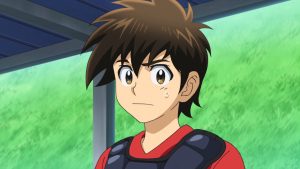 If shifts are a hot topic in pro baseball now, so is framing to be certain. In effect, it’s the art of trying to fool the umpire – to receive the ball in such a way as to convince the ump it’s a strike (whether it is or not). When you don’t move your body and reach for the ball, close pitches seem off-target – especially to volunteer umpires in little league. In sabermetric-obsessed Major League baseball fandom, the art of framing is now measured statistically – and while there isn’t universal agreement on how accurate these framing stats are, there’s a strong belief that catchers can save – or cost – their team a good many runs over the course of a season based on their framing skills.
If shifts are a hot topic in pro baseball now, so is framing to be certain. In effect, it’s the art of trying to fool the umpire – to receive the ball in such a way as to convince the ump it’s a strike (whether it is or not). When you don’t move your body and reach for the ball, close pitches seem off-target – especially to volunteer umpires in little league. In sabermetric-obsessed Major League baseball fandom, the art of framing is now measured statistically – and while there isn’t universal agreement on how accurate these framing stats are, there’s a strong belief that catchers can save – or cost – their team a good many runs over the course of a season based on their framing skills.
 Getting subbed out for Daigo is a blow, to be sure, and Tashiro doesn’t exactly soften it much. But it’s a lesson Daigo needs to learn – especially in watching the difference when Andy gets behind the plate. This is not Daigo’s fault – it’s simply a measure of the difference in their experience level. The question of whether Andy should be playing at all is another matter, of course – even if he’s correct that if this game is lost he’ll have plenty of time to heal, it’s still borderline irresponsible to put a child in that position (though such behavior is sadly the norm in youth baseball). For Daigo, at least he remains on the field (left to be precise) with an opportunity to impact the game with his glove and bat. And of even greater importance, to learn from this – to learn what separates him from being a full-fledged catcher, and how to deal with adversity and keep his head in the game.
Getting subbed out for Daigo is a blow, to be sure, and Tashiro doesn’t exactly soften it much. But it’s a lesson Daigo needs to learn – especially in watching the difference when Andy gets behind the plate. This is not Daigo’s fault – it’s simply a measure of the difference in their experience level. The question of whether Andy should be playing at all is another matter, of course – even if he’s correct that if this game is lost he’ll have plenty of time to heal, it’s still borderline irresponsible to put a child in that position (though such behavior is sadly the norm in youth baseball). For Daigo, at least he remains on the field (left to be precise) with an opportunity to impact the game with his glove and bat. And of even greater importance, to learn from this – to learn what separates him from being a full-fledged catcher, and how to deal with adversity and keep his head in the game.


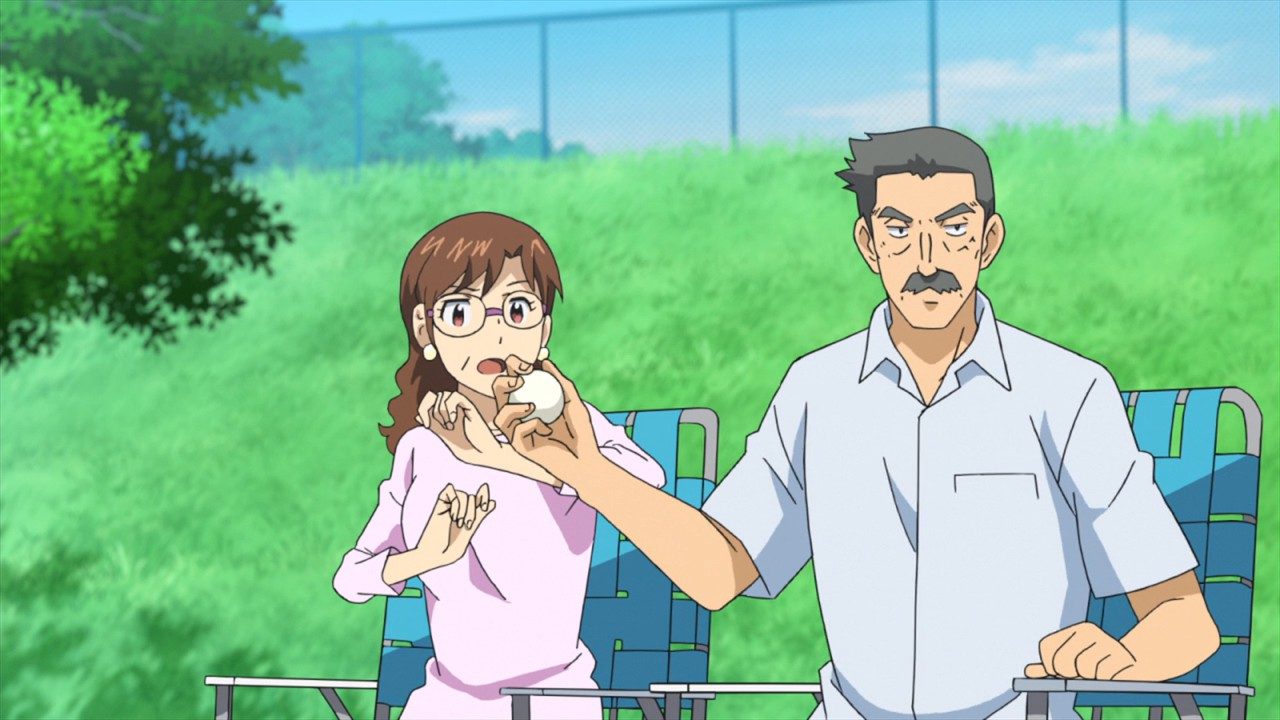
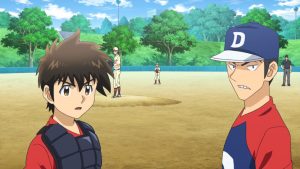
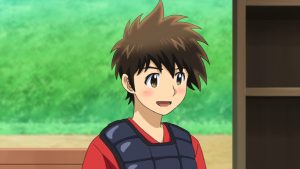
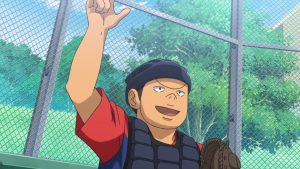
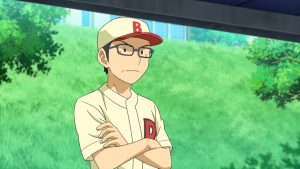
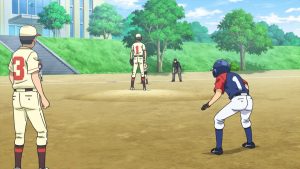
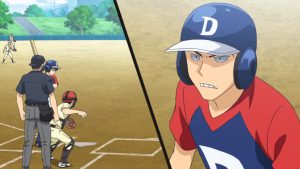


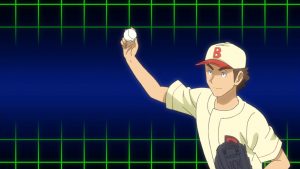


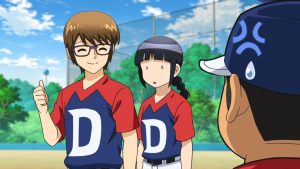

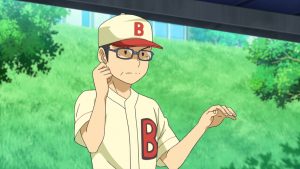



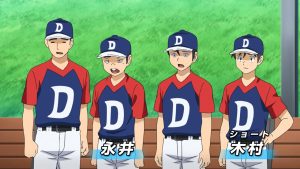

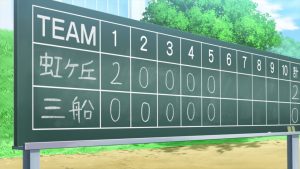
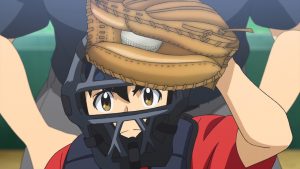

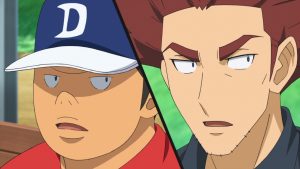
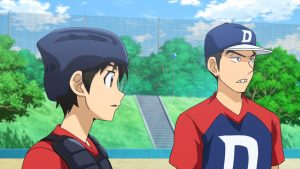


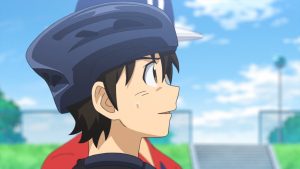
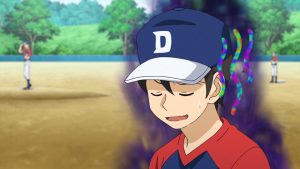
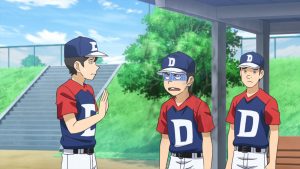
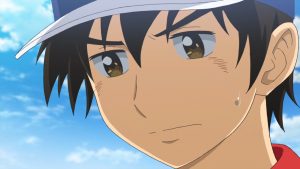

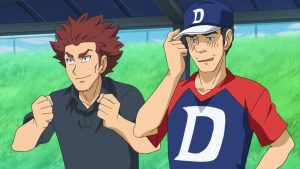
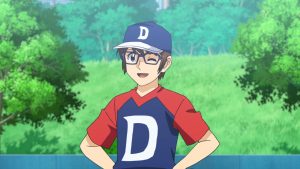
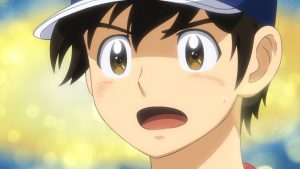

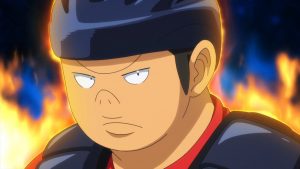
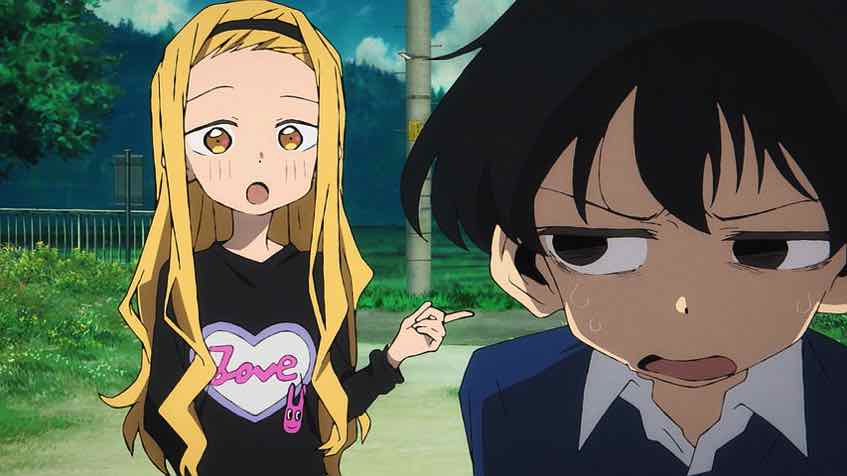
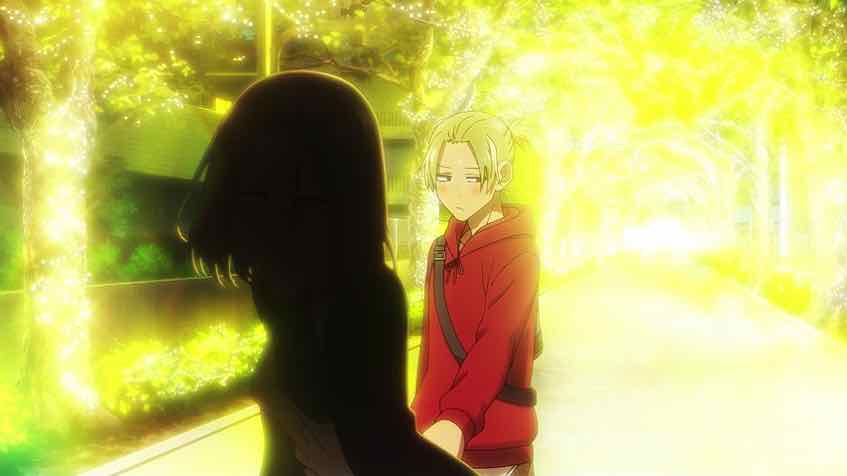
elianthos80
July 14, 2018 at 4:55 pm– ‘Fake’ Grandpa has got the moves 8D
– “Lucky!” LOL
– Collateral damage kiddo :,) but hey don’t lump him with the benchers oh noes
– Blush blush blush * pets *
– Komori(iiiii <3) the quiet menace
my loyalties are divided– Coach is growing a spine. I’m moved :,)
– Learnnnn Daigo learnnnnnn soak up that on-field experience * waving more flags *
– GLOWING AURAS. WITH FLAMING TENDRILS. * hype intensifies *
– I have pinged on the identity of Batting Blonde. Maybe.
Guardian Enzo
July 14, 2018 at 5:20 pmYes, divided loyalties. It’s very hard for me to root against Komori-kun, crows feet and all.